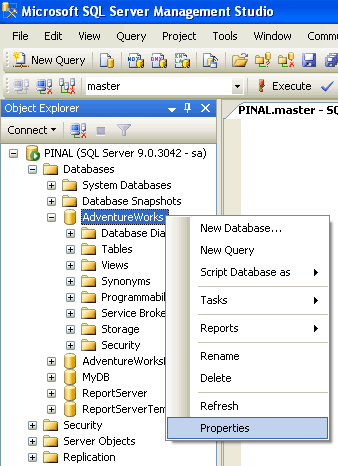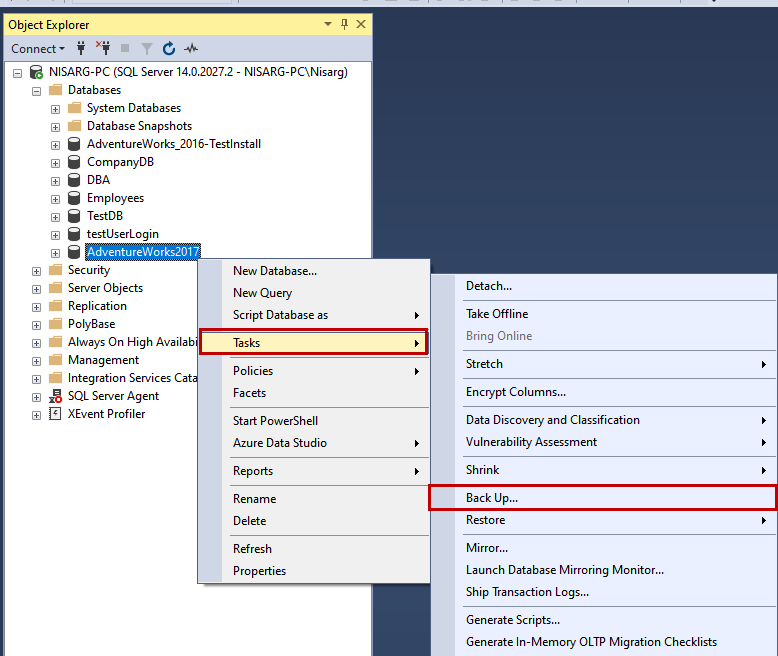

Select Create to create your new SQL Database, which is the restored copy of the AdventureWorksLT database. On the Additional settings tab, choose Sample as the existing data under Data source: Select Databases and then select SQL Database.įill in the requested information to create your database. Select Create a resource in the top left of the navigation pane. When you create a new database in Azure SQL Database, you have the option to create a blank database, restore from a backup or select sample data to populate your new database.įollow these steps to add a sample data to your new database:

To get sample data for Azure SQL Managed Instance instead, see restore World Wide Importers to SQL Managed Instance. You can use a sample when you create a new database, or you can deploy a database from SQL Server directly to Azure using SQL Server Management Studio (SSMS). You have two options to view sample Azure SQL Database data. This auto-populates the rest of the fields such as Database, Target database and Restore to.

Open Azure Data Studio Studio and connect to your SQL Server instance. To restore your database in Azure Data Studio, follow these steps: If you're not familiar using Azure Data Studio Studio, see connect & query to get started MOVE 'AdventureWorks2017_log' TO '/var/opt/mssql/data/AdventureWorks2019_log.ldf', WITH MOVE 'AdventureWorks2017' TO '/var/opt/mssql/data/AdventureWorks2019.mdf',
#Open adventureworks database with ssms windows#
To restore AdventureWorks2019 to Linux, change the Windows filesystem path to Linux, and then run the following Transact-SQL (T-SQL) command: USE įROM DISK = '/var/opt/mssql/backup/AdventureWorks2019.bak' To restore AdventureWorks2019 to Windows, modify values as appropriate to your environment and then run the following Transact-SQL (T-SQL) command: USE įROM DISK = N'C:\Program Files\Microsoft SQL Server\MSSQL15.MSSQLSERVER\MSSQL\Backup\AdventureWorks2019.bak' An example to restore AdventureWorks2019 is provided below, but the database name and installation file path may vary depending on your environment. You can restore your sample database using Transact-SQL (T-SQL). Select OK to confirm your database backup selection and close the Select backup devices window.Ĭheck the Files tab to confirm the Restore as location and file names match your intended location and file names in the Restore Database wizard.įor more information on restoring a SQL Server database, see Restore a database backup using SSMS. If you moved your file to this location but you're not able to see it in the wizard, this typically indicates a permissions issue - SQL Server or the user signed into SQL Server does not have permission to this file in this folder. bak file you recently moved to the backup location. Select Device and then select the ellipses (.) to choose a device. Right-click Databases in Object Explorer > Restore Database. Open SQL Server Management Studio (SSMS) and connect to your SQL Server. For example, the default location for a default instance of SQL Server 2019 is:Ĭ:\Program Files\Microsoft SQL Server\MSSQL15.MSSQLSERVER\MSSQL\Backup. This varies depending on your installation location, instance name and version of SQL Server. bak file to your SQL Server backup location.
#Open adventureworks database with ssms download#
bak file from one of links provided in the download backup files section. To restore your database in SQL Server Management Studio, follow these steps:ĭownload the appropriate. If you're not familiar using SQL Server Management Studio (SSMS), you can see connect & query to get started. You can do so using the RESTORE (Transact-SQL) command, or using the graphical interface (GUI) in SQL Server Management Studio or Azure Data Studio. bak file to restore your sample database to your SQL Server instance. OLTPĪdditional files can be found directly on GitHub: If you're not sure what you need, start with the OLTP version that matches your SQL Server version. Lightweight (LT) data is a lightweight and pared down version of the OLTP sample.Data Warehouse (DW) data is for data warehousing workloads.OLTP data is for most typical online transaction processing workloads.Use these links to download the appropriate sample database for your scenario. SQL Server Management Studio or Azure Data Studio.This article provides direct links to download AdventureWorks sample databases, as well as instructions for restoring them to SQL Server and Azure SQL Database.įor more information about samples, see the Samples GitHub repository. Applies to: SQL Server (all supported versions) Azure SQL Database Azure SQL Managed Instance Azure Synapse Analytics Analytics Platform System (PDW)


 0 kommentar(er)
0 kommentar(er)
